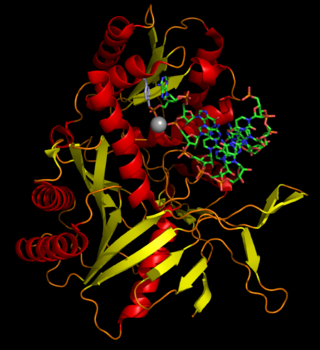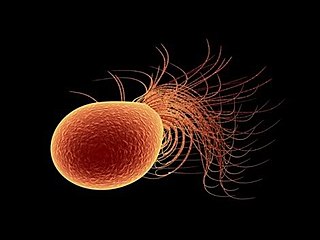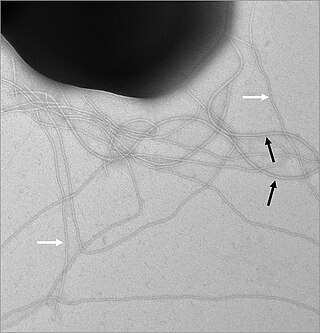
Karl Otto Stetter is a German microbiologist and authority on astrobiology. Stetter is an expert on microbial life at high temperatures.

Archaeoglobaceae are a family of the Archaeoglobales. All known genera within the Archaeoglobaceae are hyperthermophilic and can be found near undersea hydrothermal vents. Archaeoglobaceae are the only family in the order Archaeoglobales, which is the only order in the class Archaeoglobi.
Archaeoglobus is a genus of the phylum Euryarchaeota. Archaeoglobus can be found in high-temperature oil fields where they may contribute to oil field souring.
In taxonomy, the Picrophilaceae are a family of microbes within Thermoplasmatales.

Pyrococcus furiosus is a heterotrophic, strictly anaerobic, extremophilic, model species of archaea. It is classified as a hyperthermophile because it thrives best under extremely high temperatures, and is notable for having an optimum growth temperature of 100 °C. P. furiosus belongs to the Pyrococcus genus, most commonly found in extreme environmental conditions of hydrothermal vents. It is one of the few prokaryotic organisms that has enzymes containing tungsten, an element rarely found in biological molecules.
Thermoproteus is a genus of archaeans in the family Thermoproteaceae. These prokaryotes are thermophilic sulphur-dependent organisms related to the genera Sulfolobus, Pyrodictium and Desulfurococcus. They are hydrogen-sulphur autotrophs and can grow at temperatures of up to 95 °C.
Methanococcus is a genus of coccoid methanogens of the family Methanococcaceae. They are all mesophiles, except the thermophilic M. thermolithotrophicus and the hyperthermophilic M. jannaschii. The latter was discovered at the base of a “white smoker” chimney at 21°N on the East Pacific Rise and it was the first archaeal genome to be completely sequenced, revealing many novel and eukaryote-like elements.

In taxonomy, the Thermococci are a class of microbes within the Euryarchaeota.

Sulfolobaceae are a family of the Sulfolobales belonging to the domain Archaea. The family consists of several genera adapted to survive environmental niches with extreme temperature and low pH conditions.

In taxonomy, the Thermococcaceae are a family of the Thermococcales. Almost all species within the three genera of Thermococcaceae were isolated from hydrothermal vents in the ocean. All are strictly anaerobes.
Methanocaldococcus formerly known as Methanococcus is a genus of coccoid methanogen archaea. They are all mesophiles, except the thermophilic M. thermolithotrophicus and the hyperthermophilic M. jannaschii. The latter was discovered at the base of a “white smoker” chimney at 21°N on the East Pacific Rise and it was the first archaean genome to be completely sequenced, revealing many novel and eukaryote-like elements.
Pyrobaculum is a genus of the Thermoproteaceae.
Sulfurisphaera is a genus of the Sulfolobaceae.
In taxonomy, Palaeococcus is a genus of the Thermococcaceae.
In taxonomy, Thermococcus is a genus of thermophilic Archaea in the family the Thermococcaceae.

Acidilobus is a genus of archaea in the family Acidilobaceae.
In taxonomy, Methanofollis is a genus of the Methanomicrobiaceae.
Thermococcus kodakarensis is a species of thermophilic archaea. The type strain T. kodakarensis KOD1 is one of the best-studied members of the genus.
Pyrococcus abyssi is a hyperthermophilic archaeon isolated from a deep-sea hydrothermal vent in the North Fiji Basin at 2,000 metres (6,600 ft). It is anaerobic, sulfur-metabolizing, gram-negative, coccus-shaped and highly motile. Its optimum growth temperature is 96 °C (205 °F). Its type strain is GE5. Pyrococcus abyssi has been used as a model organism in studies of DNA polymerase. This species can also grow at high cell densities in bioreactors.

TACK is a group of archaea, its name an acronym for Thaumarchaeota, Aigarchaeota, Crenarchaeota, and Korarchaeota, the first groups discovered. They are found in different environments ranging from acidophilic thermophiles to mesophiles and psychrophiles and with different types of metabolism, predominantly anaerobic and chemosynthetic. TACK is a clade that is sister to the Asgard branch that gave rise to the eukaryotes. It has been proposed that the TACK clade be classified as Crenarchaeota and that the traditional "Crenarchaeota" (Thermoproteota) be classified as a class called "Sulfolobia", along with the other phyla with class rank or order.








